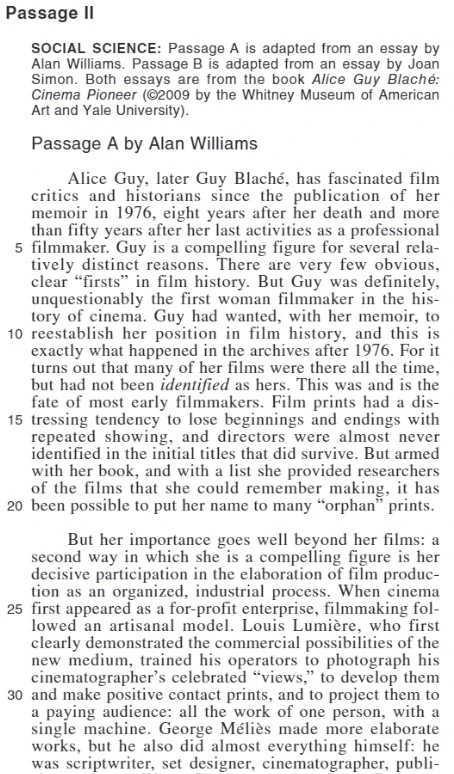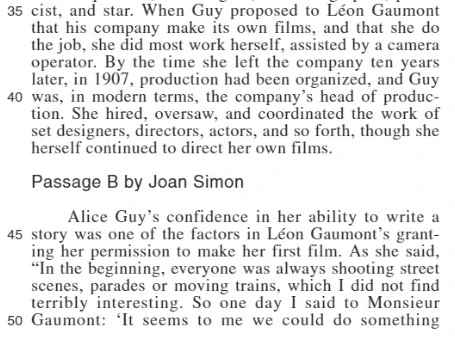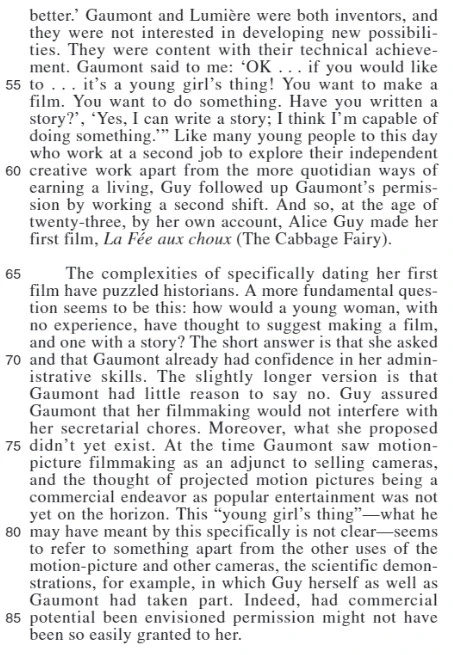Section: Reading 0 Likes
Passage II - SOCIAL SCIENCE: Passage A is adapted from an essay by (September 2023 - G01)



Questions from Passage II
Questions 11–15 ask about Passage A
11) It can reasonably be inferred from Passage A that the organized industrial process of filmmaking differed from the artisanal model in that artisanal filmmaking was accomplished through the work of:
A. a head of production and numerous film crew artists.
B. one person doing almost all of the film production jobs.
C. one set designer and a company owner.
D. a publicist, a scriptwriter, and a star.
12) Passage A most strongly suggests that Guy is primarilyrecognized for her role as:
F. a writer of film history.
G. a camera technician at Gaumont studios.
H. the first woman filmmaker.
J. Lumière’s favorite cinematographer.
13) Based on Passage A, what is one reason many earlyfilm prints lost their beginnings and endings?
A. Repeated showings
B. Researchers’ handling of films
C. The quality of the archive storage facility
D. Directors’ lack of skill in film production
14) The author of Passage A indicates that researchers were able to identify some early film prints as Guy’spartly because:
F. each film was shelved alphabetically by the film-maker’s name.
G. Guy created a list of the films she made.
H. the prints had original labels with Guy’s namewritten on them.
J. historians and film critics kept accurate records.
15) As it is used in line 20, the word putmost nearlymeans:
A. position.
B. deposit.
C. assign.
D. gauge.
Questions 16 and 17 ask about Passage B
16) The main purpose of the last paragraph in Passage B is to:
F. describe how Guy’s filmmaking career came to an end.
G. detail Gaumont’s confidence in Guy’s technical abilities as a filmmaker.
H. explain why Guy was given the opportunity tomake films.
J. clarify the differences between Guy’s and Gaumont’s work as filmmakers.
17) Details in Passage B most strongly suggest that Guywas initially employed by Gaumont as:
A. an inventor of cameras.
B. a camera salesperson.
C. a film publicist.
D. a secretary.
Questions 18–20 ask about both passages
18) Compared to Passage B, Passage A provides more information about the:
F. complexities of identifying the early films of Guy and other filmmakers.
G. films Guy made with her husband later in her career.
H. process leading up to Guy making her first film.
J. tasks Guy carried out for Lumière and Gaumont.
19) Which of the following statements is supported byboth passages?
A. Guy made her first film at the age of twenty-three.
B. Guy believed that many films in the historical film archives were hers.
C. Guy wrote her memoir to reestablish her place in film history.
D. Guy helped to shape the role of filmmaker in the early days of film.
20) Which of the following statements best captures a main difference in the focus of the passages?
F. Passage A focuses on Guy’s overall importance tofilm history, while Passage B focuses on the details regarding her start in filmmaking.
G. Passage A focuses on Guy’s work in the early part of the twentieth century, while Passage B focuses on her work in the 1970s.
H. Passage A focuses on Guy’s work with Lumière,while Passage B focuses on her work with Gaumont.
J. Passage A focuses on Guy as a camera operator,while Passage B focuses on her work as a film producer.
Solution
Correct answer:
11 - B
12 - H
13 - A
14 - G
15 - C
16 - H
17 - D
18 - F
19 - D
20 - F
Exam Edition: September 2023 - G01
Exam Year: 2023
Related topics: Text Comprehension, Text Reading